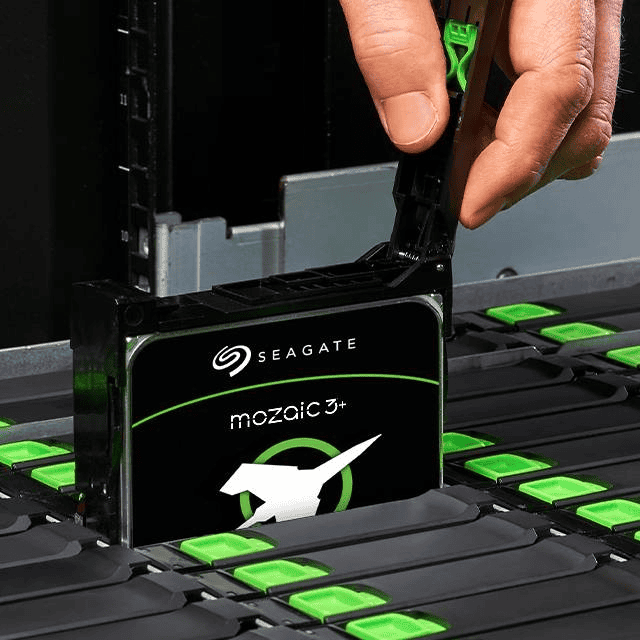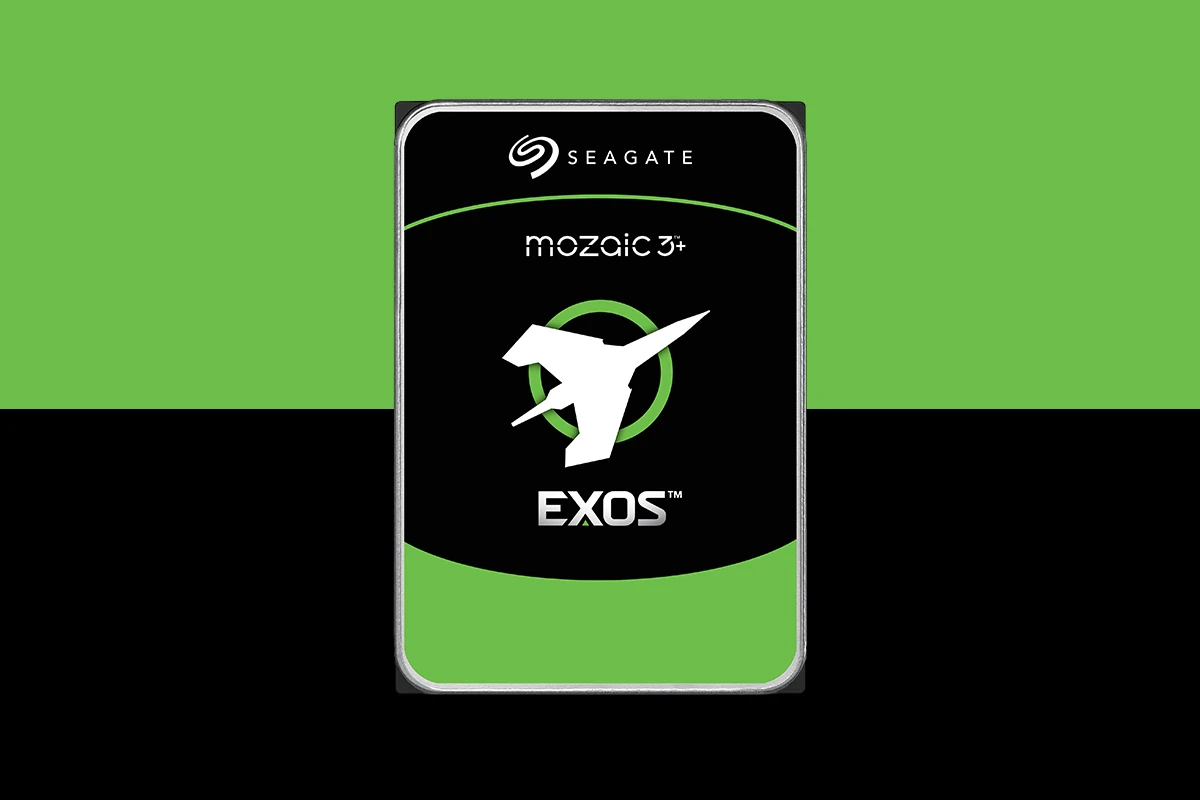Seagate has unveiled its latest innovation in data storage technology. The company has launched its first mass-produced hard drives using Heat-Assisted Magnetic Recording (HAMR) technology. These new Exos M hard drives offer capacities of 32TB and 30TB, marking a significant leap in storage density for enterprise-grade HDDs.
The Exos M series utilizes Seagate’s Mozaic 3+ platform, which incorporates HAMR technology. This advancement allows for greater data density on the disk surface. HAMR works by applying localized heat to the disk during the writing process, enabling smaller magnetic grains to store data reliably.
Seagate’s breakthrough comes after 16 years of development, showcasing the company’s commitment to pushing the boundaries of storage technology. The new drives are available in 30TB CMR and 32TB SMR versions, catering to different enterprise storage needs.

The Dawn of High-Capacity Storage: HAMR Arrives
Seagate’s Breakthrough with HAMR Technology
Seagate has officially launched its 32TB Exos hard drives featuring Heat-Assisted Magnetic Recording (HAMR) technology. This marks a significant advancement in hard drive technology and represents the first commercially available drives using this approach to increase storage density. This breakthrough is a big deal for data storage.
Exos M Series for Enterprise and Hyperscale Needs
These new drives are part of Seagate’s Exos M series, designed for enterprise-level storage and hyperscale data centers. These environments require massive storage capacity and reliable performance, making HAMR a perfect fit. It’s built for the big leagues of data.
Mozaic 3+ Platform: The Foundation of HAMR
Seagate’s HAMR implementation is based on its Mozaic 3+ platform. This platform combines several key innovations:
- New Media: The drives use new platter materials that can withstand the heat generated by the HAMR process.
- Laser-Equipped Write Heads: Tiny lasers are integrated into the read/write heads to heat the disk surface during writing.
- Other Advancements: The Mozaic 3+ platform includes further improvements to achieve higher areal density.
Significance of the HAMR Launch
This launch is a landmark moment for the storage industry for several reasons:
- HAMR’s Commercial Debut: After years of development, HAMR technology has finally arrived in commercial products.
- Increased Storage Density: HAMR enables a substantial jump in storage density, allowing for larger capacity drives in the same physical size.
- Competitive Landscape: Seagate’s launch strengthens its position in the storage market, especially against competitors using other high-capacity recording technologies.
Key Features of Seagate’s 32TB HAMR Drives
| Feature | Details |
|---|---|
| Capacity | 32TB |
| Technology | HAMR (Heat-Assisted Magnetic Recording) |
| Series | Exos M |
| Platform | Mozaic 3+ |
| Target Market | Enterprise, Hyperscale Data Centers |
Key Takeaways
- Seagate’s Exos M drives offer up to 32TB capacity using HAMR technology
- HAMR technology enables higher data density through localized heating
- The new drives target enterprise storage applications with CMR and SMR options
Technological Advancements in Seagate’s HAMR Hard Drives
Seagate’s new HAMR hard drives represent a significant leap in storage technology. These drives incorporate cutting-edge components and innovative design to achieve unprecedented storage capacities and performance.

Innovative HAMR Technology
Heat-Assisted Magnetic Recording (HAMR) is the cornerstone of Seagate’s latest hard drives. This technology uses a tiny laser to heat the disk surface momentarily, allowing data to be written to much smaller areas.
The key components of HAMR include:
- Plasmonic writer: Focuses laser energy onto a precise spot
- Nanophotonic laser: Generates the heat needed for writing data
- Iron-platinum superlattice: A new recording medium that enables higher data density
These elements work together to dramatically increase storage capacity without increasing the physical size of the drive.
Key Features of the 32TB Exos M Series
The 32TB Exos M hard drive showcases several advanced features:
- Mozaic 3+ platform: Seagate’s latest drive architecture
- Gen 7 spintronic reader: Improves data reading accuracy
- Magnetic field reading sensors: Enhance data retrieval performance
These drives are designed for enterprise use, offering high reliability and performance. They are compatible with existing data center infrastructure, making adoption easier for businesses.
Improvements in Areal Density and Storage Capacity
HAMR technology has enabled significant improvements in areal density, the amount of data that can be stored per unit area. The 32TB Exos M drives achieve:
- 3TB per platter: A major increase over previous generations
- Higher overall capacity: 32TB in a standard 3.5-inch form factor
This increased density allows for more efficient data storage, reducing the physical space required for large amounts of data. It also potentially lowers power consumption and cooling needs in data centers.
The advancements in areal density pave the way for future drives with even higher capacities, potentially reaching 100TB or more in the coming years.
Impact on Data Storage and Performance
Seagate’s 32TB Exos M HAMR drives represent a significant leap in storage capacity and performance. These drives offer enhanced data density and improved power efficiency, addressing the growing needs of data-intensive industries.
Meeting the Demands of Cloud Service Providers
The 32TB HAMR HDDs cater to the escalating storage requirements of cloud service providers. These drives enable more efficient use of data center space, reducing overall infrastructure costs.
Exos M drives offer higher storage density, allowing cloud providers to store more data in the same physical footprint. This increased capacity helps manage the exponential growth of data in cloud environments.
The improved power efficiency of HAMR technology translates to lower energy consumption per terabyte. This reduction in power usage can lead to significant cost savings for large-scale data centers.
Potential Use Cases and Industries
HAMR technology opens up new possibilities for data-intensive applications across various industries. Video and imaging applications benefit from the increased storage capacity, enabling higher resolution content and longer retention periods.
AI and machine learning workloads can leverage the larger storage capacity for training datasets and model storage. This allows for more complex and accurate AI models to be developed and deployed.
CorVault systems and other backup solutions can utilize HAMR drives to store more data with fewer physical units. This improves backup and disaster recovery capabilities for businesses of all sizes.
Comparing HAMR to Previous Technologies
HAMR technology offers several advantages over previous magnetic recording methods. Compared to Perpendicular Magnetic Recording (PMR), HAMR allows for significantly higher data density on each platter.
Conventional Magnetic Recording (CMR) and Shingled Magnetic Recording (SMR) have limitations in areal density that HAMR overcomes. This results in higher capacity drives without increasing the number of platters.
HAMR drives provide better performance than SMR drives in random write operations. This makes them more suitable for a wider range of workloads, including those with frequent data modifications.
The transition to HAMR technology positions hard disk drives to remain competitive with solid-state drives in terms of capacity and cost per terabyte. This ensures HDDs continue to play a crucial role in data storage solutions.







